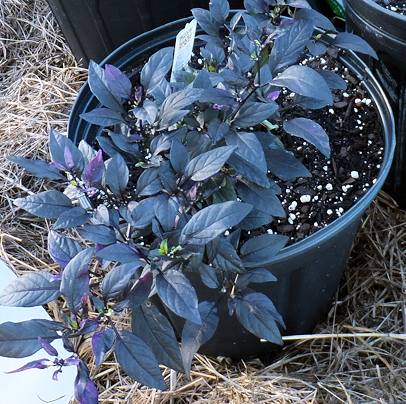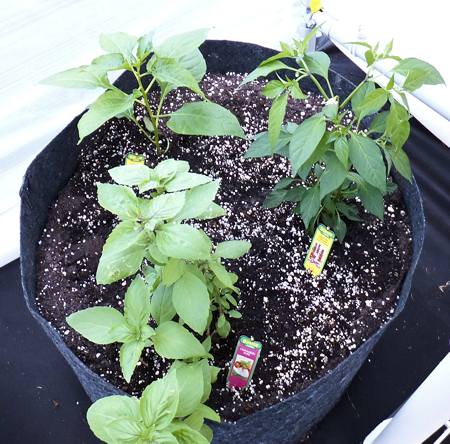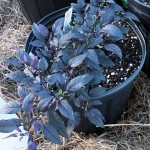Pepper Garden – Fall 2014 Redoux
For my homegrown peppers garden a la Fall 2014, there have already been changes. It’s amazing how fast plans can go out the door and vanish! But, I have new pepper plants in place, so here’s the (new) lineup.
Before I list the peppers, I’ll note that my plans changed because of two things. The first is my greenhouse and the second is the Fall/Winter weather predictions for South Florida. It’s supposed to get rather chilly early on, and a cooler Fall/Winter overall, compared to 2013.
Fall 2014 Pepper Lineup, Take 2

Purple Flash, Early September 2014.
Given the above, my plans changed to buy some starter plants and not grow as many of the seeds (waiting until Thanksgiving to plant those). So here goes for what’s now on deck.
Purple Flash: This is a pepper with purple foliage. The new leaves are green, kind of variegated. As they get older, they turn a lovely dusky purple. Peppers start as purple, then turn red as they mature. Since I bought it as a starter, I picked off all the peppers after I transplanted so as to de-stress the plant. I have it planted in a 5-gallon container.
Cayenne Yellow: A cayenne pepper, only with peppers that mature to a lemon-color, instead of red. It’s supposed to be just as hot as a regular cayenne. I have it cohabiting with a pepper called Cajun Bell in a 12-gallon grow bag / smart pot.
Cajun Belle: This is interesting; it’s a hybrid bell peppers that supposedly is a little on the spicy side. Who could resist — not me, for sure! So I planted it with Cayenne Yellow, as well as an Italian basil plant.
Dragon Cayenne: The name drew me in, so I figured I’d grow it and compare to the Yellow Cayenne plant. It’s sharing a 20-gallon smart pot with a Tabasco pepper and some cinnamon basil.

Tabasco (upper left), Dragon Cayenne (upper right) and Cinnamon Basil (foreground). These were just planted 3 days ago.
Tabasco: I don’t recall if this one had a specific variety name, but I picked it to grow for two reasons. First, if I’ve ever grown Tabasco peppers, it’s been years and years, so why not try them? Second, the plant was so pretty! So, in the grow bag with the Dragon Cayenne and basil.
Habanero: No variety listed. I almost didn’t get this starter plant, because habanero peppers typically take a long time to fruit, and it’s already the middle of September. But, I have a greenhouse, so what the heck — live a little! (And hopefully the plant will live more than a little, LOL.) I haven’t decided on where to put this one yet.
Red Bell Pepper: No specific variety name. I didn’t have any regular bells as a starter plant so thought I’d add this one in. It’s also waiting doe its home….which I suspect will be with the habanero. And more basil, or perhaps oregano.
For seedlings that have already popped their heads up, I have:
Fooled You Jalepeno: A no-heat jalapeno pepper, which I have never grown before. It’s a hybrid, and I’ll see how “no heat” it turns out to be. I am growing this mostly for my husband David, who prefers the no-heat.
Trinidad Perfume: This was in my original lineup, and it’s a no-heat habanero. This one is really for me, since I have no idea what a habanero really tastes like — it’s usually all I can do to fan my mouth and look around for ice cream to cool the burn when I eat the regular ones. 😉
Flamingo: A pretty bell pepper that changes colors as the pepper matures. This one is sweet (unlike Cajun Belle). Looking forward to trying it.
Tri-Fetti: This is one of my old (5+ years) seeds. I planted quite a few, not knowing how many would germinate (if any). I see at least one of them coming up, and I think a second one as well. The plants are gorgeous, and I have a hard time finding the seeds, so I am glad that I’ll have some plants and be able to save some new seeds. These are mostly ornamental, but the peppers are edible – and hot!
Orange Thai Hot: These are also from the 5+ year old seed batch, but they aren’t showing any signs of germination yet. Still early days, though, so I’ll wait another couple of weeks to see if I get anything from them.
That’s it for now, but I’ll keep you posted on their progress.
Germinating Pepper Seeds, Update
It’s been just over a week since I planted my latest batch of pepper seeds, both hot and sweet. So what’s sprouting already?
And the Winner Is…
Corno di Toro, a sweet pepper, was first out of the gate at 5 days. However, of the two seeds I’ve planted, only one has shown up yet. On the other hand, I planted two different strains (confused yet?). At any rate, the red Corno di Toro is the clear winner.
Jalapeno M was the second to sprout at 6 days, with both seeds coming on up. Jalapeno M was closely followed by Cambuci Hot, about a half day behind.
The next two sprouted at nearly the same time — Nardello Sweet and Mini Belle.
And finally this morning — Mustard Habanero. Wow, a super-hot pepper in 7.5 days — amazing.
I’m Waiting On
Some “hotties” — Hot-Banero, Peter Pepper and Bhut Jolokia. Also lagging are two more jalapenos — Jaloro and Tam Jalapeno. Brazillian Rainbow is also nowhere to be seen yet. I know — patience! And considering 10 to 21 days is the usual for hot chile peppers, it’s great that some have already shown their faces (er, leaves). Yes, the seed germination mat I talked about does work well, shaving days off the sprouting.
Thinking About a Transplant
Purira pepper (quite hot) is growing very strong and looks like it will need its final transplant before going outside to harden off for the garden in the next few days. Seeing as I did its first transplant early last week, this one appears to be a winner!
Other pepper seeds that need their final transplants before hardening off include Redskin, Anconcagua and the last of the sweet banana peppers. For Sweet Pickle I just did its first transplant on Saturday, and it appears that it will need its second transplant this weekend — wow, that was fast!
More Seeds?
I think I’ll take a short break, since I have at least 20 pepper plants at the moment, not counting the ones that are just now sprouting. Come the middle of April, it will be time to start thinking about my late Summer wave. I’m planning on the following peppers for then: Datil, Tennessee Teardrop, Ring of Fire, Yellow Cayenne and Scotch Bonnet. On the cooler side it will be more Sweet Banana, along with Anconcagua and probably Nardello Sweet. Perhaps Mini Belle again, if small bell peppers work well for me.
Have You Planted Your Seeds Yet?
I know, it’s been a cold winter, and for many of you, putting pepper plants into the garden is many months away. But for you folks in zones 8, 9 and 10 — it’s pepper “prime time”. Get planting!
P.S. — it’s a few hours later and both my Corno di Toro, both Cambuci and both Mustard Habaneros are up. Even Peter Pepper is starting to break through! What a difference a few hours can make. 🙂
Germinating Hot Pepper Seeds
Germinating hot pepper seeds is a little different from germinating sweet peppers, at least in my experience. And the more exotic the pepper, the more particular they may be about sprouting.
Here are some tips for growing hot chile peppers from seeds.
Peppers Like it Hot!
While you can coax sweet and bell peppers to germinate in a moderate soil of 70-75 degrees Fahrenheit, the chile peppers like their roots warmer…sometimes much warmer! In fact, some of the hottest of the peppers — like habanero, jolokia and scotch bonnet — prefer soil temperatures of 85 degrees or more before raising their little heads.
If you’re lucky enough to be gardening in a warm climate where the soil is already 80 degrees or more, you’ll likely be able to get the seeds to sprout. If you’re like the vast majority of us, those hot pepper seeds will need a little help. Even I need help in S. Florida during the winter and early spring!
Have They Spouted Yet?
Another trait hot peppers like jalapenos, cayenne, datil and more share is a long germination time. While sweet peppers can spring above ground within 7 to 10 days, hot peppers tend to take longer. Sometimes a lot longer!
I’ve found that most of my hot peppers sprout within a 12 to 18 day period. However, the very hottest can take up to a month (and boy, is the wait ever hard).
Help for Germinating Hot Pepper Seeds
Warmth is the biggest key in successfully germinating the chile pepper seeds. If you have a very warm spot in your home, like on a radiator, you may be good to go. For the rest of us, a seed germination mat is the best way to safely and gently warm the soil.
Something else I’ve found very useful, which surprised me in my trials, is using Terracycle. Terracycle is a gentle liquid fertilizer made from worm castings. After I moisten my seed-starting mix normally, I plant my seeds. After lightly covering my seeds with more soil mix, I spray Terracyle on the soil to dampen. Then, I give the soil a spritz every 2 or 3 days, to keep things moist.
Between the heat mat and the Terracycle, I’ve been able to shave time off the normal germination period, between 2 and 7 days. That may not sound like a lot earlier, but for anyone who’s (impatiently) waiting, any time saved is helpful.
One thing you don’t need for germination is light — seeds germinate fine in the dark. However, once the seeds have germinated, you’ll need to ensure the seedlings get 12 to 16 hours of light a day. A sunny windowsill is great, but I’ve also found that using fluorescent light bulbs works well (especially when I run out of space on my windowsills). 🙂
If you are looking for a seed germination mat, here are some for your consideration. Happy hot peppers!!!
